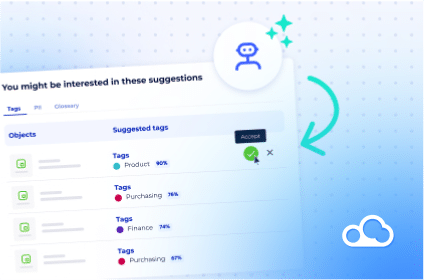For businesses looking to build the best data architecture, the choice between a data mesh and a data fabric can be a challenging one. These two approaches, while similar in their goal of organizing data, have some key differences. In this article, we will explore the concept of data mesh and data fabric, their differences, and their benefits.
What is data mesh?
Zhamak Dehghani, a consultant at ThoughtWorks, introduced the concept of a data mesh. The goal of a data mesh is to solve synchronization issues that can arise between data lakes and data warehouses, especially for teams that manage and process a large volume of data sources quickly.
Data mesh focuses on data filtering, organization, and accessibility, and it uses a domain-oriented architecture. Each domain manages its data pipeline and is responsible for processing the data. Data is organized by business area and jointly owned by data owners. This approach enables teams to source actionable data based on their specific requirements, avoiding duplication of effort and providing autonomy.
The data mesh architecture is also designed to promote organizational change. It leverages team expertise to create and design a business-oriented data product. The process of creating a data mesh requires breaking down silos between teams and adopting a culture of data ownership and governance.
Benefits of data mesh
One of the primary advantages of a data mesh architecture is its flexibility. It allows for creating self-service data products, which can be designed and owned by the teams that use them. This enables teams to work more efficiently and quickly respond to changing business needs.
Another benefit of a data mesh architecture is that it can help to avoid the “big bang” approach to data management. With a data mesh, teams can start small and gradually expand their data capabilities over time. This approach reduces the risk of failure and enables teams to iterate and improve their processes as they go.
What is data fabric?
A data fabric is a new type of data management system that uses automated data integration or data engineering to create a categorized environment. This environment then secures the work with artificial intelligence and metadata automation.
The data fabric architecture is designed to manage various levels of diversity, distribution, and complexity of data resources. It provides better visibility into data and actionable information. Data access, control, and security are also improved, thanks to metadata and centralized data engineering.
Benefits of data fabric
One of the key benefits of a data fabric architecture vs. data mesh is its ability to provide a unified view of data across an organization. It does this by providing a single, standardized platform for data management. This approach simplifies data integration and enables teams to work more efficiently.
Another advantage of data fabric architecture is that it can help improve data governance. By providing a centralized platform for data management, data fabric architecture can ensure that data is consistent, accurate, and secure. This approach can help to avoid the problems that can arise from siloed data, such as duplicate or inconsistent data.
Data mesh vs. data fabric: Key differences
While data mesh and data fabric are both data management architectures, they have different focuses. A data mesh architecture is more concerned with organizational change and uses team expertise to create and design a business-oriented data product. On the other hand, a data fabric architecture is more concerned with technology and uses metadata and centralized data engineering to improve the overall experience of enterprise data users.
Additionally, data mesh architecture emphasizes data ownership and governance, breaking down silos between teams, and promoting a culture of data ownership. In contrast, data fabric architecture emphasizes automated data integration or data engineering, metadata automation, and artificial intelligence.
Choosing the right data architecture for your business
Choosing the right data architecture for your business depends on your specific requirements and goals. If your organization has many different teams that process and manage data, a data mesh architecture might be a good fit. On the other hand, if your organization requires improved data access, control, and security, a data fabric architecture might be a better choice.
Another factor to consider when choosing between data mesh vs. data fabric architecture is the complexity of your data environment. If your organization deals with a high volume of complex data that requires advanced data engineering, a data fabric architecture might be the best fit. Alternatively, if your organization requires a more flexible approach to data management, a data mesh architecture might be a better choice.
Combining data mesh and data fabric for organizational success
Choosing between data mesh vs. data fabric architecture is not a one-size-fits-all decision. The choice will depend on your specific business needs, goals, and data environment. While data mesh architecture is more focused on organizational change and emphasizes team ownership and governance, data fabric architecture is more focused on technology and emphasizes automated data engineering and metadata automation.
Both data mesh and data fabric architectures benefit organizations looking to improve their data management practices. It’s essential to evaluate both architectures’ pros and cons and determine which best aligns with your business objectives. Ultimately, the decision may come down to a combination of both data mesh and data fabric architecture to meet the needs of your organization. Whatever architecture you choose, it’s essential to prioritize data ownership, governance, and security to ensure that your organization gets the most value from its data.
Conclusion
In conclusion, the choice between data mesh vs. data fabric architecture requires careful consideration of the unique needs of your organization. While each approach has its strengths, the decision may not be an either-or scenario. A hybrid approach that blends the benefits of both architectures may be the best fit. It’s important to prioritize data ownership, governance, and security to ensure that your organization gets the most value from its data. With the right architecture in place, organizations can improve their data management practices, increase efficiency, and drive better business outcomes.
—
Learn even more about using your data as an asset to achieve higher levels of data governance and data quality with DataGalaxy! Book a demo today to get started on your organization’s journey to complete data lifecycle management and begin your first use case in 90 days or less.





